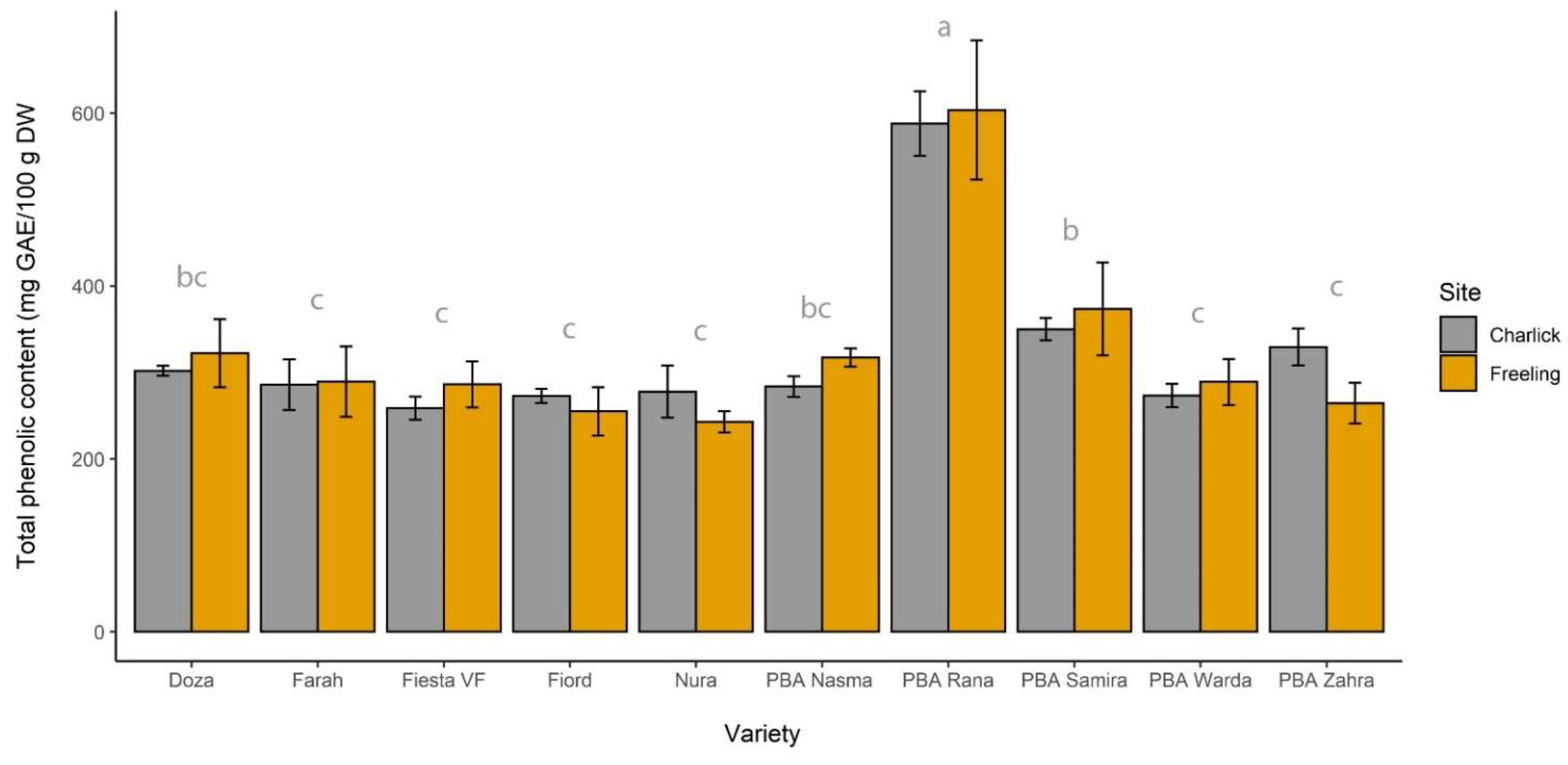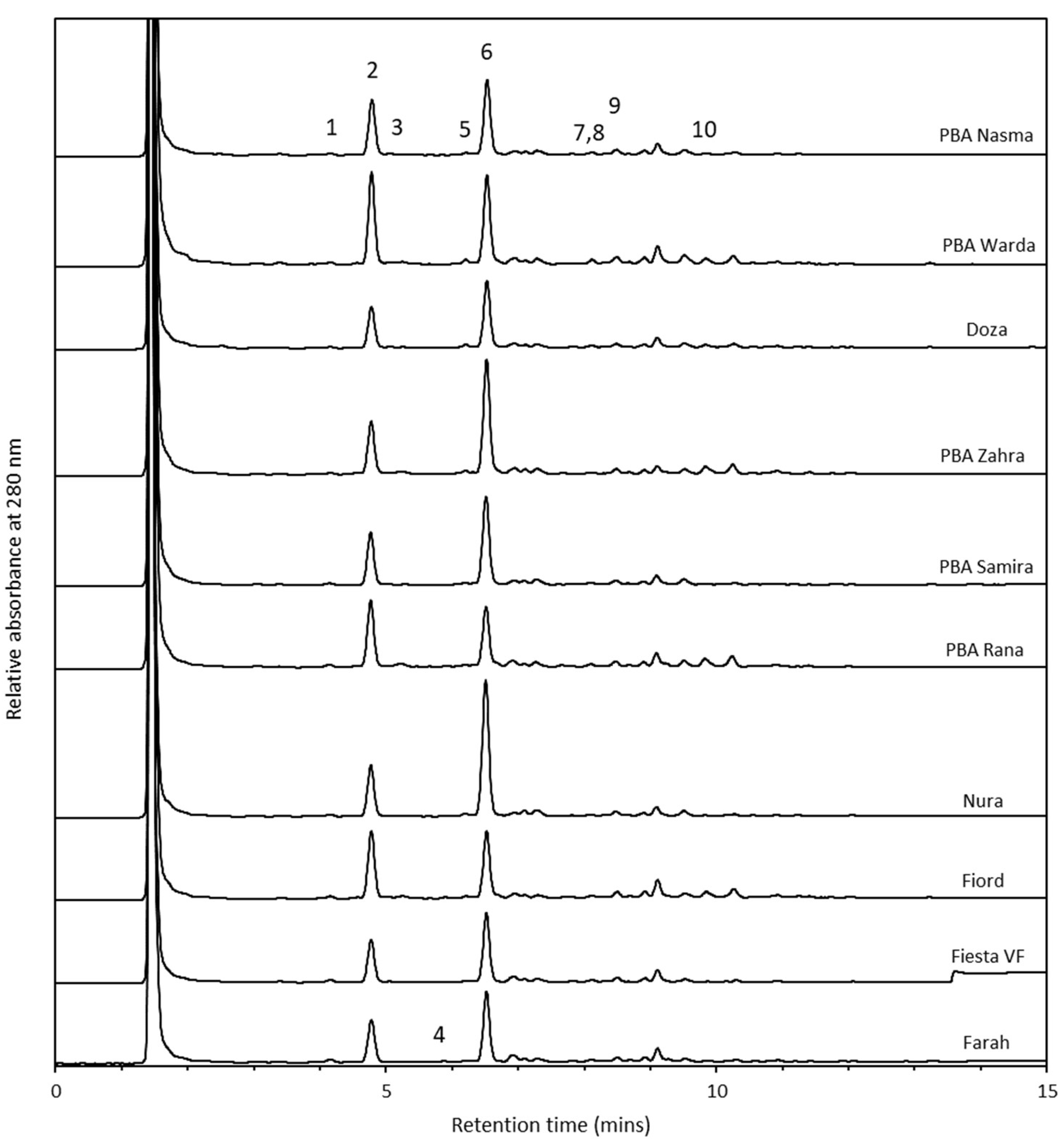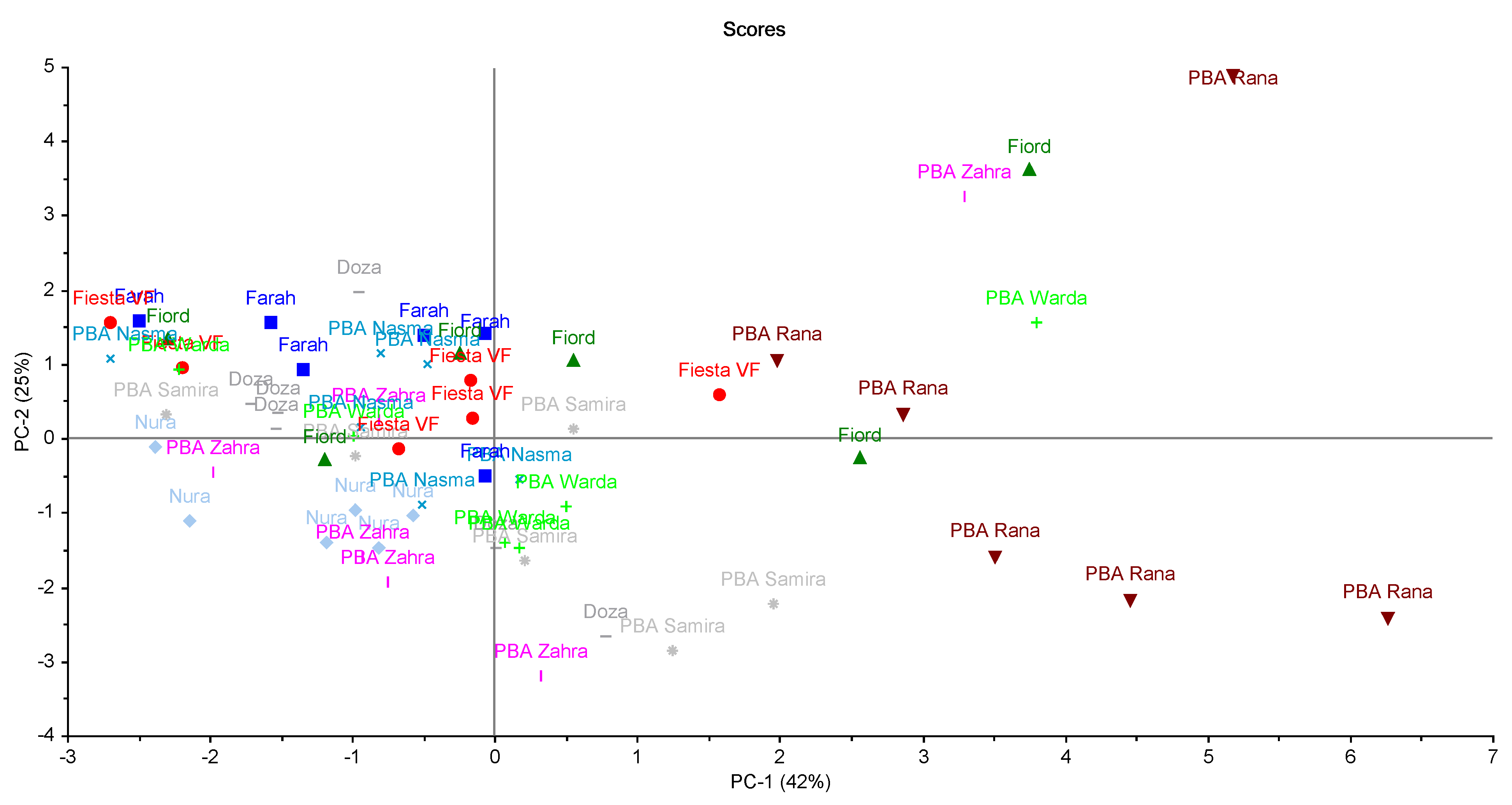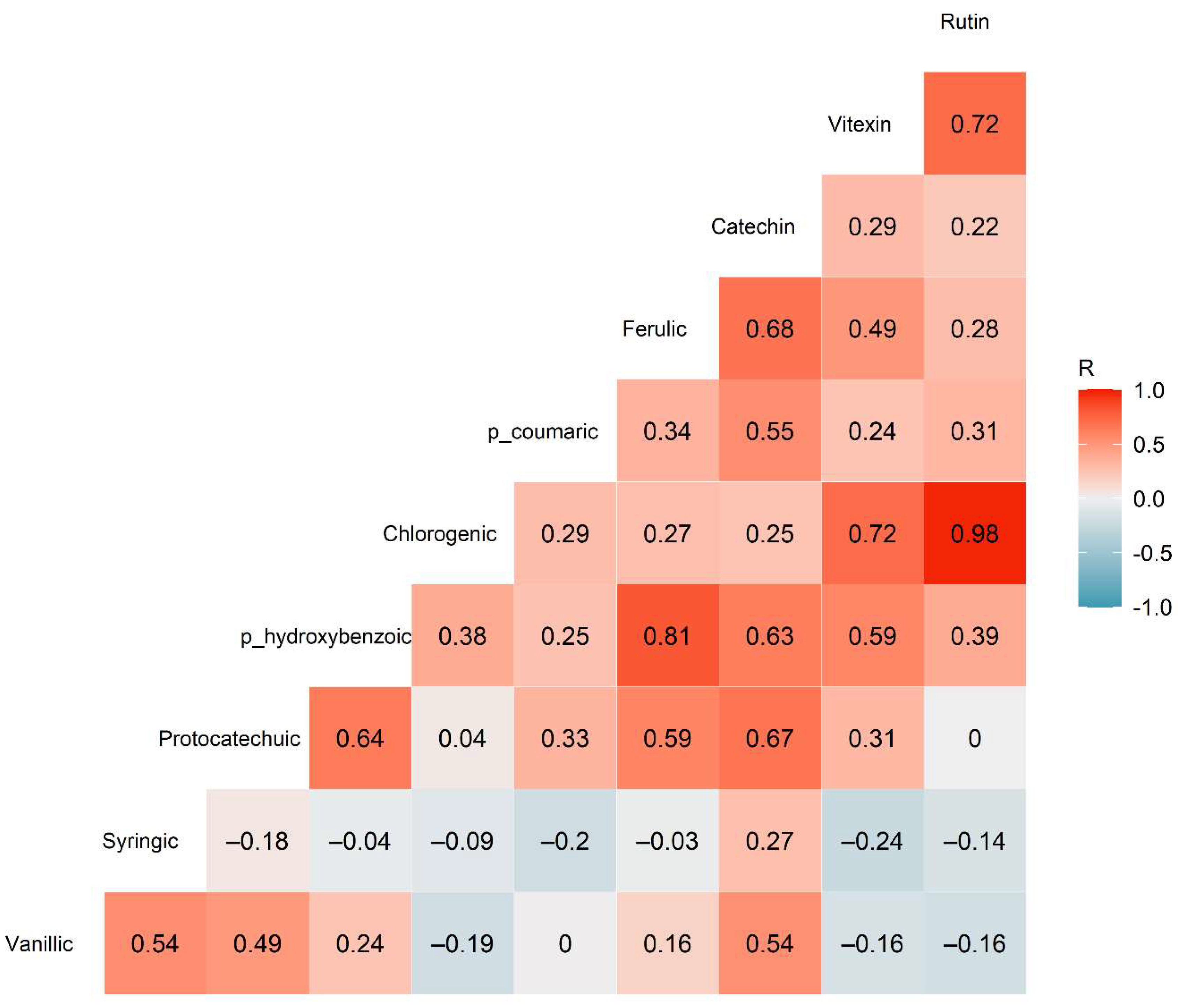Phenolic Profiles of Ten Australian Faba Bean Varieties
Abstract
:1. Introduction
2. Results and Discussion
2.1. Total Phenolic Contents
2.2. Phenolic acid Profiling by HPLC
2.3. Principal Component Analysis and Correlation Analysis
3. Materials and Methods
3.1. Seed Material
3.2. Extraction of Phenolic Compounds
3.3. Phenolic Profiling by HPLC
3.4. Data Analysis
4. Conclusions
Author Contributions
Funding
Institutional Review Board Statement
Informed Consent Statement
Data Availability Statement
Acknowledgments
Conflicts of Interest
References
- Rahate, K.A.; Madhumita, M.; Prabhakar, P.K. Nutritional composition, anti-nutritional factors, pretreatments-cum-processing impact and food formulation potential of faba bean (Vicia faba L.): A comprehensive review. LWT-Food Sci. Technol. 2021, 138, 110796. [Google Scholar] [CrossRef]
- AEGIC. Australian Pulses: Quality, Versatility, Nutrition. Available online: https://www.aegic.org.au (accessed on 6 February 2019).
- Sharan, S.; Zanghelini, G.; Zotzel, J.; Bonerz, D.; Aschoff, J.; Saint-Eve, A.; Maillard, M.-N. Fava bean (Vicia faba L.) for food applications: From seed to ingredient processing and its effect on functional properties, antinutritional factors, flavor, and color. Compr. Rev. Food Sci. Food Saf. 2021, 20, 401–428. [Google Scholar] [CrossRef]
- Turco, I.; Ferretti, G.; Bacchetti, T. Review of the health benefits of Faba bean (Vicia faba L.) polyphenols. J. Food Nutr. Res. 2016, 55, 283–293. [Google Scholar]
- Siah, S.D.; Konczak, I.; Agboola, S.; Wood, J.A.; Blanchard, C.L. In vitro investigations of the potential health benefits of Australian-grown faba beans (Vicia faba L.): Chemopreventative capacity and inhibitory effects on the angiotensin-converting enzyme, α-glucosidase and lipase. Br. J. Nutr. 2012, 108, S123–S134. [Google Scholar] [CrossRef] [PubMed] [Green Version]
- Jakubczyk, A.; Karaś, M.; Złotek, U.; Szymanowska, U.; Baraniak, B.; Bochnak, J. Peptides obtained from fermented faba bean seeds (Vicia faba) as potential inhibitors of an enzyme involved in the pathogenesis of metabolic syndrome. LWT-Food Sci. Technol. 2019, 105, 306–313. [Google Scholar] [CrossRef]
- Boudjou, S.; Oomah, B.D.; Zaidi, F.; Hosseinian, F. Phenolics content and antioxidant and anti-inflammatory activities of legume fractions. Food Chem. 2013, 138, 1543–1550. [Google Scholar] [CrossRef] [PubMed]
- Spanou, C.; Veskoukis, A.S.; Kerasioti, T.; Kontou, M.; Angelis, A.; Aligiannis, N.; Skaltsounis, A.-L.; Kouretas, D. Flavonoid Glycosides Isolated from Unique Legume Plant Extracts as Novel Inhibitors of Xanthine Oxidase. PLoS ONE 2012, 7, e32214. [Google Scholar] [CrossRef] [Green Version]
- Zanotto, S.; Khazaei, H.; Elessawy, F.M.; Vandenberg, A.; Purves, R.W. Do Faba Bean Genotypes Carrying Different Zero-Tannin Genes (zt1 and zt2) Differ in Phenolic Profiles? J. Agric. Food Chem. 2020, 68, 7530–7540. [Google Scholar] [CrossRef] [PubMed]
- Xiang, J.; Zhang, M.; Apea-Bah, F.B.; Beta, T. Hydroxycinnamic acid amide (HCAA) derivatives, flavonoid C-glycosides, phenolic acids and antioxidant properties of foxtail millet. Food Chem. 2019, 295, 214–223. [Google Scholar] [CrossRef] [PubMed]
- Valente, I.M.; Maia, M.R.G.; Malushi, N.; Oliveira, H.M.; Papa, L.; Rodrigues, J.A.; Fonseca, A.J.M.; Cabrita, A.R.J. Profiling of phenolic compounds and antioxidant properties of European varieties and cultivars of Vicia faba L. pods. Phytochemistry 2018, 152, 223–229. [Google Scholar] [CrossRef]
- Valente, I.M.; Cabrita, A.R.J.; Malushi, N.; Oliveira, H.M.; Papa, L.; Rodrigues, J.A.; Fonseca, A.J.M.; Maia, M.R.G. Unravelling the phytonutrients and antioxidant properties of European Vicia faba L. seeds. Food Res. Int. 2019, 116, 888–896. [Google Scholar] [CrossRef] [PubMed]
- Baginsky, C.; Peña-Neira, Á.; Cáceres, A.; Hernández, T.; Estrella, I.; Morales, H.; Pertuzé, R. Phenolic compound composition in immature seeds of fava bean (Vicia faba L.) varieties cultivated in Chile. J. Food Compos. Anal. 2013, 31, 1–6. [Google Scholar] [CrossRef]
- Chaieb, N.; González, J.L.; López-Mesas, M.; Bouslama, M.; Valiente, M. Polyphenols content and antioxidant capacity of thirteen faba bean (Vicia faba L.) genotypes cultivated in Tunisia. Food Res. Int. 2011, 44, 970–977. [Google Scholar] [CrossRef]
- Nasar-Abbas, S.; Siddique, K.; Plummer, J.; White, P.; Harris, D.; Dods, K.; D’antuono, M. Faba bean (Vicia faba L.) seeds darken rapidly and phenolic content falls when stored at higher temperature, moisture and light intensity. LWT-Food Sci. Technol. 2009, 42, 1703–1711. [Google Scholar] [CrossRef] [Green Version]
- Siah, S.; Konczak, I.; Wood, J.A.; Agboola, S.; Blanchard, C.L. Effects of roasting on phenolic composition and in vitro antioxidant capacity of Australian grown faba beans (Vicia faba L.). Plant Foods Hum. Nutr. 2014, 69, 85–91. [Google Scholar] [CrossRef] [PubMed]
- Siah, S.; Wood, J.A.; Agboola, S.; Konczak, I.; Blanchard, C.L. Effects of soaking, boiling and autoclaving on the phenolic contents and antioxidant activities of faba beans (Vicia faba L.) differing in seed coat colours. Food Chem. 2014, 142, 461–468. [Google Scholar] [CrossRef]
- Johnson, J.; Collins, T.; Skylas, D.; Quail, K.; Blanchard, C.; Naiker, M. Profiling the varietal antioxidative content and macrochemical composition in Australian faba beans (Vicia faba L.). Legume Sci. 2020, 2, e28. [Google Scholar] [CrossRef] [Green Version]
- Ryszard, A.; Fereidoon, S. Antioxidant activity of faba bean extract and fractions thereof. J. Food Bioact. 2018, 2, 112–118. [Google Scholar] [CrossRef] [Green Version]
- Choudhary, D.K.; Chaturvedi, N.; Singh, A.; Mishra, A. Characterization, inhibitory activity and mechanism of polyphenols from faba bean (gallic-acid and catechin) on α-glucosidase: Insights from molecular docking and simulation study. Prep. Biochem. Biotechnol. 2020, 50, 123–132. [Google Scholar] [CrossRef]
- Liu, Y.; Ragaee, S.; Marcone, M.F.; Abdel-Aal, E.-S.M. Composition of Phenolic Acids and Antioxidant Properties of Selected Pulses Cooked with Different Heating Conditions. Foods 2020, 9, 908. [Google Scholar] [CrossRef] [PubMed]
- Sosulski, F.W.; Dabrowski, K.J. Composition of free and hydrolyzable phenolic acids in the flours and hulls of ten legume species. J. Agric. Food Chem. 1984, 32, 131–133. [Google Scholar] [CrossRef]
- Dong, Y.; Dong, K.; Yang, Z.X.; Zheng, Y.; Tang, L. Microbial and physiological mechanisms for alleviating fusarium wilt of faba bean in intercropping system. Ying Yong Sheng Tai Xue Bao 2016, 27, 1984–1992. [Google Scholar] [CrossRef]
- El-Akkad, S.S.; Hassan, E.A.; Ali, M.E. Phenolic acid changes during Orobanche parasitism on faba bean and some other hosts. Egypt. J. Biol. 2002, 4, 37–44. [Google Scholar]
- Yao, Y.; Cheng, X.-Z.; Ren, G.-X. Contents of D-chiro-Inositol, Vitexin, and Isovitexin in Various Varieties of Mung Bean and Its Products. Agric. Sci. China 2011, 10, 1710–1715. [Google Scholar] [CrossRef]
- Abu-Reidah, I.M.; del Mar Contreras, M.; Arráez-Román, D.; Fernández-Gutiérrez, A.; Segura-Carretero, A. UHPLC-ESI-QTOF-MS-based metabolic profiling of Vicia faba L. (Fabaceae) seeds as a key strategy for characterization in foodomics. Electrophoresis 2014, 35, 1571–1581. [Google Scholar] [CrossRef] [PubMed]
- Johnson, J.B.; Mani, J.S.; Skylas, D.; Walsh, K.B.; Bhattarai, S.P.; Naiker, M. Phenolic profiles and nutritional quality of four new mungbean lines grown in northern Australia. Legume Sci. 2020. early online. [Google Scholar] [CrossRef]
- Mpofu, A.; Sapirstein, H.D.; Beta, T. Genotype and Environmental Variation in Phenolic Content, Phenolic Acid Composition, and Antioxidant Activity of Hard Spring Wheat. J. Agric. Food Chem. 2006, 54, 1265–1270. [Google Scholar] [CrossRef]
- Oomah, B.D.; Luc, G.; Leprelle, C.; Drover, J.C.G.; Harrison, J.E.; Olson, M. Phenolics, Phytic Acid, and Phytase in Canadian-Grown Low-Tannin Faba Bean (Vicia faba L.) Genotypes. J. Agric. Food Chem. 2011, 59, 3763–3771. [Google Scholar] [CrossRef]
- Santos-Sánchez, N.F.; Salas-Coronado, R.; Hernández-Carlos, B.; Villanueva-Cañongo, C. Shikimic acid pathway in biosynthesis of phenolic compounds. In Plant Physiological Aspects of Phenolic Compounds; Soto-Hernández, M., García-Mateos, R., Palma-Tenango, M., Eds.; IntechOpen: London, UK, 2019. [Google Scholar] [CrossRef] [Green Version]
- Fraser, C.M.; Chapple, C. The Phenylpropanoid Pathway in Arabidopsis. Arab. Book 2011, 2011. [Google Scholar] [CrossRef] [Green Version]
- Marchiosi, R.; dos Santos, W.D.; Constantin, R.P.; de Lima, R.B.; Soares, A.R.; Finger-Teixeira, A.; Mota, T.R.; de Oliveira, D.M.; Foletto-Felipe, M.d.P.; Abrahão, J.; et al. Biosynthesis and metabolic actions of simple phenolic acids in plants. Phytochem. Rev. 2020, 19, 865–906. [Google Scholar] [CrossRef]
- Skylas, D.J.; Paull, J.G.; Hughes, D.G.; Gogel, B.; Long, H.; Williams, B.; Mundree, S.; Blanchard, C.L.; Quail, K.J. Nutritional and anti-nutritional seed-quality traits of faba bean (Vicia faba) grown in South Australia. Crop Pasture Sci. 2019, 70, 463–472. [Google Scholar] [CrossRef]
- R Core Team. R: A Language and Environment for Statistical Computing, version 4.0.2; R Foundation for Statistical Computing: Vienna, Austria, 2020. [Google Scholar]




| Compound | Doza | Farah | Fiesta VF | Fiord | Nura | PBA Nasma | PBA Rana | PBA Samira | PBA Warda | PBA Zahra | p Value |
|---|---|---|---|---|---|---|---|---|---|---|---|
| Protocatechuic acid | 1.88 ± 0.83 b | 1.45 ± 0.61 b | 1.44 ± 0.50 b | 1.66 ± 0.77 b | 1.29 ± 0.22 b | 1.65 ± 0.60 b | 2.93 ± 1.07 a | 2.09 ± 0.77 ab | 1.83 ± 0.56 b | 1.81 ± 0.36 b | *** |
| p-hydroxybenzoic acid | 0.57 ± 0.06 bcd | 0.52 ± 0.07 cd | 0.52 ± 0.11 cd | 0.64 ± 0.18 bcd | 0.44 ± 0.08 d | 0.62 ± 0.13 bcd | 1.11 ± 0.21 a | 0.73 ± 0.15 bc | 0.61 ± 0.10 bcd | 0.79 ± 0.11 b | *** |
| Vanillic acid | 2.46 ± 0.59 ab | 1.87 ± 0.37 b | 1.96 ± 0.36 b | 1.88 ± 0.43 b | 2.40 ± 0.24 ab | 1.96 ± 0.29 b | 2.24 ± 0.68 ab | 2.81 ± 0.52 a | 2.71 ± 0.40 a | 2.76 ± 0.85 a | *** |
| Syringic acid | 77.6 ± 11.2 c | 72.4 ± 7.9 c | 80.5 ± 13.1 c | 77.6 ± 11.8 c | 149.8 ± 14.8 a | 77.8 ± 9.5 c | 72.5 ± 7.3 c | 109.6 ± 21.6 b | 80.9 ± 14.1 c | 122.5 ± 14.4 b | *** |
| Sum of hydroxybenzoic acids | 82.5 ± 12.6 c | 76.2 ± 8.5 c | 84.4 ± 13.7 c | 81.8 ± 12.7 c | 153.9 ± 14.9 a | 82.0 ± 10.3 c | 78.8 ± 8.8 c | 115.2 ± 22.8 b | 86.0 ± 14.8 c | 127.9 ± 15.4 b | *** |
| Chlorogenic acid | 0.89 ± 0.96 | 0.85 ± 0.52 | 1.27 ± 1.30 | 2.88 ± 2.56 | 0.78 ± 0.41 | 0.89 ± 0.44 | 3.02 ± 3.31 | 1.14 ± 0.73 | 1.70 ± 2.48 | 1.98 ± 3.41 | NS |
| p-coumaric acid | 1.21 ± 0.21 bc | 1.64 ± 0.25 ab | 1.86 ± 0.40 a | 1.69 ± 0.28 ab | 1.26 ± 0.16 abc | 1.52 ± 0.37 abc | 1.70 ± 0.27 ab | 1.52 ± 0.38 abc | 1.62 ± 0.54 ab | 0.95 ± 0.17 c | *** |
| trans-ferulic acid | 1.27 ± 0.22 b | 0.96 ± 0.21 b | 1.11 ± 0.27 b | 1.42 ± 0.42 b | 1.36 ± 0.32 b | 1.22 ± 0.35 b | 2.99 ± 0.65 a | 1.34 ± 0.25 b | 1.26 ± 0.30 b | 1.82 ± 0.18 b | *** |
| Sum of hydroxycinnamic acids | 3.37 ± 1.09 b | 3.45 ± 0.76 b | 4.24 ± 1.81 ab | 5.99 ± 2.97 ab | 3.40 ± 0.68 b | 3.63 ± 0.85 ab | 7.71 ± 2.83 a | 4.00 ± 1.17 ab | 4.58 ± 3.22 ab | 4.11 ± 3.60 ab | * |
| Catechin | 216 ± 64 ab | 191 ± 37 b | 215 ± 52 ab | 245 ± 52 ab | 232 ± 27 ab | 207 ± 37 b | 297 ± 53 a | 240 ± 55 ab | 258 ± 63 ab | 220 ± 33 ab | * |
| Vitexin | 0.88 ± 0.24 b | 1.70 ± 1.82 ab | 0.97 ± 0.39 b | 1.52 ± 1.82 ab | 0.58 ± 0.41 b | 0.80 ± 0.28 b | 3.50 ± 1.43 a | 0.75 ± 0.43 b | 1.21 ± 0.82 b | 1.43 ± 1.52 ab | ** |
| Rutin | 5.55 ± 5.02 | 7.34 ± 5.11 | 7.66 ± 6.36 | 13.91 ± 11.81 | 4.04 ± 3.00 | 4.50 ± 2.30 | 15.87 ± 14.22 | 7.67 ± 4.09 | 10.48 ± 10.60 | 9.43 ± 16.29 | NS |
| Sum of flavonoids | 223 ± 61 ab | 200 ± 37 b | 223 ± 57 ab | 261 ± 61 ab | 237 ± 28 ab | 212 ± 37 b | 316 ± 45 a | 248 ± 56 ab | 269 ± 71 ab | 231 ± 35 ab | * |
| Compound | Charlick (n = 30) | Freeling (n = 30) | Site p Value | Variety × Site Interaction |
|---|---|---|---|---|
| Protocatechuic acid | 1.43 ± 0.36 | 2.17 ± 0.87 | *** | NS |
| p-hydroxybenzoic acid | 0.67 ± 0.19 | 0.64 ± 0.25 | NS | NS |
| Vanillic acid | 2.11 ± 0.41 | 2.50 ± 0.67 | *** | ** |
| Syringic acid | 89.3 ± 28.2 | 94.9 ± 27.9 | NS | * |
| Sum of hydroxybenzoic acids | 93.5 ± 28.3 | 100.2 ± 28.4 | * | * |
| Chlorogenic acid | 2.22 ± 2.57 | 0.86 ± 0.68 | ** | NS |
| p-coumaric acid | 1.45 ± 0.42 | 1.55 ± 0.38 | NS | NS |
| trans-ferulic acid | 1.45 ± 0.47 | 1.38 ± 0.77 | NS | ** |
| Sum of hydroxycinnamic acids | 5.11 ± 3.00 | 3.78 ± 1.39 | * | NS |
| Catechin | 224 ± 45 | 240 ± 60 | NS | NS |
| Vitexin | 1.67 ± 1.56 | 0.98 ± 0.86 | * | NS |
| Rutin | 12.21 ± 11.59 | 5.07 ± 3.54 | ** | NS |
| Sum of flavonoids | 238 ± 52 | 246 ± 62 | NS | NS |
| No. | Compound | Retention Time (min) | Wavelength (nm) | Slope | LOD (mg L−1) | LOQ (mg L−1) | Calibration R2 |
|---|---|---|---|---|---|---|---|
| Hydroxybenzoic acids | |||||||
| 1 | Protocatechuic acid | 3.94 | 250 nm | 13.5 | 0.1 | 0.4 | 1 |
| 4 | p-hydroxybenzoic acid | 5.78 | 250 nm | 25.9 | 0.1 | 0.2 | 1 |
| 5 | Vanillic acid | 6.26 | 250 nm | 12.3 | 0.1 | 0.4 | 1 |
| 6 | Syringic acid | 6.59 | 280 nm | 15.1 | 0.1 | 0.3 | 1 |
| Hydroxycinnamic acids | |||||||
| 3 | Chlorogenic acid | 5.26 | 320 nm | 14.1 | 0.1 | 0.4 | 1 |
| 7 | p-coumaric acid | 8.12 | 320 nm | 32.3 | 0.05 | 0.2 | 1 |
| 9 | trans-ferulic acid | 8.44 | 320 nm | 26.9 | 0.1 | 0.2 | 1 |
| Flavonoids | |||||||
| 2 | Catechin | 4.55 | 280 nm | 4.0 | 0.4 | 1.3 | 1 |
| 8 | Vitexin | 8.17 | 320 nm | 7.3 | 0.2 | 0.7 | 0.9999 |
| 10 | Rutin | 9.82 | 250 nm | 6.2 | 0.2 | 0.8 | 1 |
Publisher’s Note: MDPI stays neutral with regard to jurisdictional claims in published maps and institutional affiliations. |
© 2021 by the authors. Licensee MDPI, Basel, Switzerland. This article is an open access article distributed under the terms and conditions of the Creative Commons Attribution (CC BY) license (https://creativecommons.org/licenses/by/4.0/).
Share and Cite
Johnson, J.B.; Skylas, D.J.; Mani, J.S.; Xiang, J.; Walsh, K.B.; Naiker, M. Phenolic Profiles of Ten Australian Faba Bean Varieties. Molecules 2021, 26, 4642. https://doi.org/10.3390/molecules26154642
Johnson JB, Skylas DJ, Mani JS, Xiang J, Walsh KB, Naiker M. Phenolic Profiles of Ten Australian Faba Bean Varieties. Molecules. 2021; 26(15):4642. https://doi.org/10.3390/molecules26154642
Chicago/Turabian StyleJohnson, Joel B., Daniel J. Skylas, Janice S. Mani, Jinle Xiang, Kerry B. Walsh, and Mani Naiker. 2021. "Phenolic Profiles of Ten Australian Faba Bean Varieties" Molecules 26, no. 15: 4642. https://doi.org/10.3390/molecules26154642
APA StyleJohnson, J. B., Skylas, D. J., Mani, J. S., Xiang, J., Walsh, K. B., & Naiker, M. (2021). Phenolic Profiles of Ten Australian Faba Bean Varieties. Molecules, 26(15), 4642. https://doi.org/10.3390/molecules26154642










